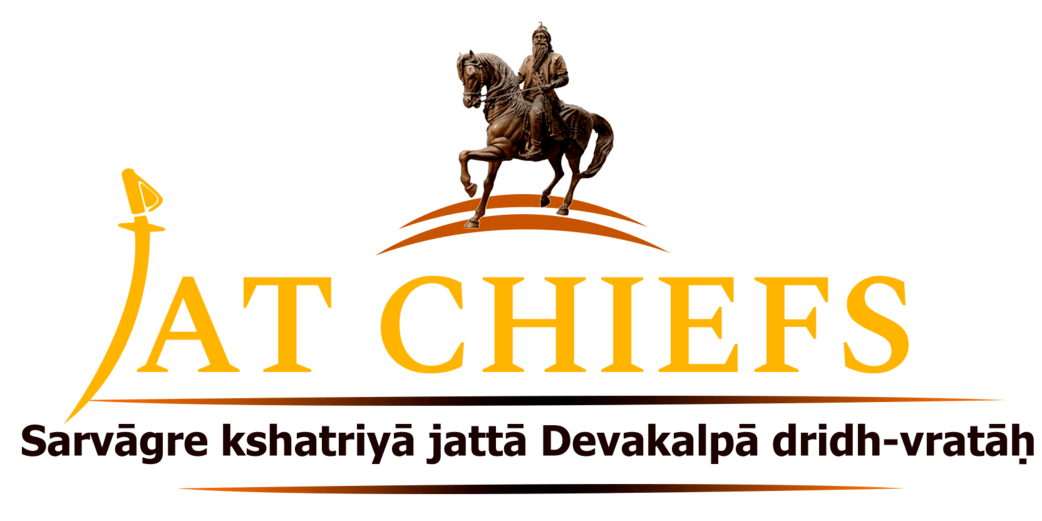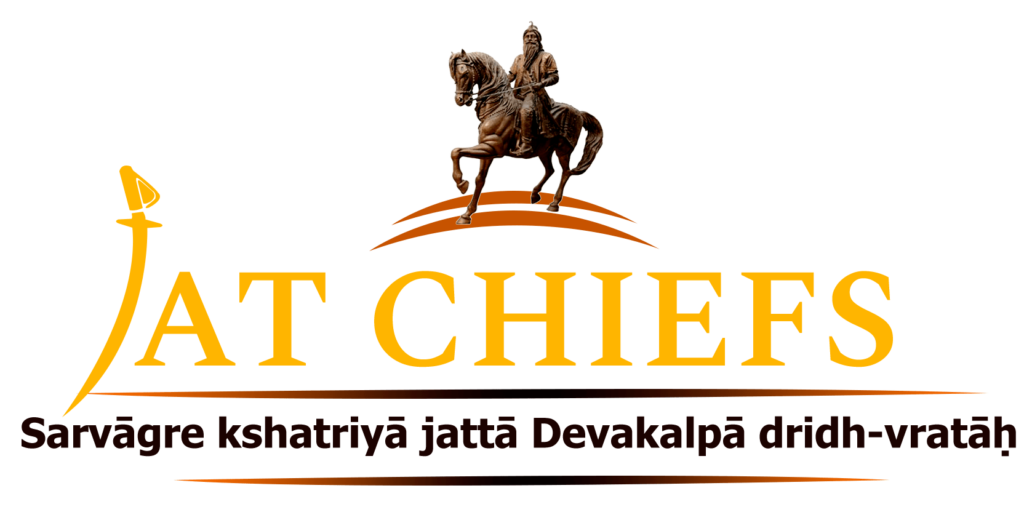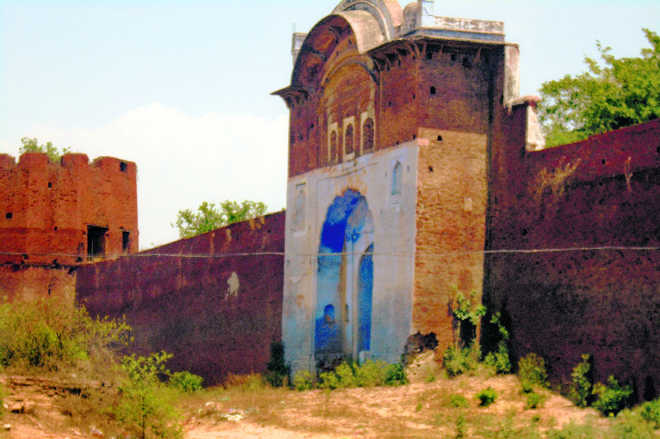History
The founders of the Buria chiefship were Nanu Singh, a Jat of Jhawal Madan, near Amritsar, and the brothers, Bhag Singh and Rai Singh, all Bhangi Chiefs, who, in 1764, seized the fort of Buria from some Narwaria Sikhs who had entered into possession a year pre-viously. Nan Singh was shortly afterwards treacherously murdered by the Afghans of Aurangabad, who enticed him inside their fort under the pretence of showing him hospitality. His death was revenged by Rai Singh, the adopted son of Nana Singh, who, with Bhag Singh, defeated the Aurangabadis, levelling their fort, and possessing himself of about 200 villages in the neighbourhood. These were divided between the brothers, Rai Singh receiving 84 villages in the districts of Jaga-dhri and Dayalgarh, while Bhag Singh became sole owner of the Buria. estates, consisting of 120 villages. On the death of Bhag Singh in 1829, his son Sher Singh held the chiefship. He was killed in an engagement with the English at Saharanpur in 1804. Then arose a long dispute between his widows and sons affecting the succession, which ended in the estate being held in equal shares by Jaimal Singh and Gulab Singh, the widows taking certain villages in life-tenure by way of maintenance. Gulab Singh ultimately succeeded to the whole estate on the death, without sons, of his brother Jaimal in 1816. He himself died in 1848, leaving an only son, Jiwan Singh, not then a year old. Buria was reduced to the level of an ordinary jagir holding with the other minor Cis-Sutlej chiefships in June, 1849, when, immediately after the Second Sikh War, their criminal, civil and fiscal jurisdiction was annulled, and their lands came under the operation f the law as administered in the Punjab generally. During both the Sutlej campaigns SardarJiwan Singh’s relatives behaved with cou-spicuous loyalty. In the war of 1849 they furwished levies and advanced Bs. 50,000 on loan to the military treasury. During the Mutiny the young Sardar himself commanded a body of 20 horsemen and 86 footmen locally raised and maintained at his own charge, and held the town of Jagadhri for some weeks. He, on this ovasion, also lent a considerable sum of money to assist the authorities in meeting the current expenses of the war. His services were rewarded hy a remission for one year of his commutation payment of Rs. 4,138, and by a permanent reduction of the demand to one half.
SardarJiwan Singh was an Honorary Magistrate, Honorary Civil Judge and Sub-Registrar within the limits of his estates. He was one of the most enlightened of the Sikh JatJagirdars of the Ambala district.
He was a Provincial Darbari and was honoured in 1887 by being made the recipient of the Order of the Indian Empire in recognition of his public services. His jagirs and muafs yielded an income of Rs. 47,700, and his rents from proprietary holdings amounted to Rs. 8,300 per annum. The Sardar was connected by marriage with the ruling family of Patiala, his sister having married Maharaja Narendra Singh.
SardarJiwan Singh died in 1893 and was succeeded by his grand-son, Lachhman Singh, a minor, whose estates remained under the care of the Court of Wards until he attained majority in 1912 when he was given over their control. He was educated at the Aitchison College, Lahore. He was appointed an Honorary Magistrate and a Civil Judge at Buria.
During the Great War, SardarLachhman Singh provided 199 recruits and contributed Rs. 25,000 to the War Loan, another Rs. 6,000 to various funds connected with that campaign, and a motor car. In 1916, he was granted the title of Sardar Bahadur and given 18 aquares of land in the Montgomery Colony.
The Sardar Bahadur died in 1921, leaving behind two minor sons from his second wife, named KunwarRatanAmol Singh and LalAmol Singh.
His estates, therefore, went again under the Court of Wards and the two brothers was receiving their education at the Aitchison College, Lahore. later KunwarRatanAmol Singh become successor of Buria Estate and become Raja .
Genealogy
- Sardar NANU SINGH, 1st Ruler of Buria in 1764, married and had adoptive issue. He was killed at Aurangabad Fort by treachery in 1764.
- Sardar Bhag Singh (qv)
- Sardar Rai Singh Bhangi of Jagadhri ( See - Jagadhri )
- Sardar BHAG SINGH, 2nd Ruler of Buria 1764/1785, with Rai Singh Bhangi, he avenged his adoptive father's death, by defeating the Aurangabadis and levelling their Fort, thus capturing
about 200 villages, which was divided between them, Rai Singh taking 84 villages, forming his estates of Jagadhari and Dyalghar, while Bhag Singh took the rest, which formed his estate of Buria; married and had issue. He died 1785/1786.
- Sardar Sher Singh (qv)
- Sardar SHER SINGH, 3rd Ruler of Buria 1786/1804, after his death a long dispute arose between the widows and the sons of the late Sardar, viz. Jaimal Singh and Gulab Singh, which ended in
the estate being divided between the sons; and on the death of Jaimal Singh in 1817, Gulab Singh succeeded to the whole; married and had issue. He was killed in an engagement with the British at Saharanpur in 1804/1805
- Sardar Jaimal Singh (qv)
- Sardar Gulab Singh (qv)
- Sardar JAIMAL SINGH, 4th Ruler of Buria 1805/1817, married Rani Nand Kaur, she died 1835. He died spm in 1817 (1816?).
- Sardar GULAB SINGH, 5th Ruler of Buria 1817/1844, married and had issue. He died 1844.
- Sardar Jiwan Singh [Jiun Singh] (qv)
- Maharani Karm Kaur, married Maharaja Narendra Singh of Patiala.
- Sardar JIWAN SINGH C.I.E, 6th Chief of Buria 1844/-; born 1842, he was an Honorary Magistrate, Honorary Civil Judge and Sub-Registrar within the limits of his estates; he was one of the most enlightened of the Sikh Chiefs of the Ambala district and was honoured in 1887 by
being the recipient of the Order of the Indian Empire, conferred in recognition of his loyal public services; his jagirs and muafis yielded an income of Rs5,500; and his rents from proprietary holdings amounted to Rs41,500 per annum; Darbari of Ambala District, 2nd in order of Precedence within the Division and 35th in the Province; married and had issue. He died 1893.
- Kanwar Gajinder Singh, born 1869, married and had issue. He died 1890.
- Sardar Bahadur Sardar Lachhman Singh (qv)
- Kanwar Madan Singh, born 1888
- Kanwar Gajinder Singh, born 1869, married and had issue. He died 1890.
- Sardar Bahadur Sardar LACHHMAN SINGH, 7th Chief of Buria 1890/1921, educated at Aitchison College, Lahore, he succeeded his grandfather as a minor under the management of the Court of
Wards until 1912 when he attained his majority and was granted management rights; he was appointed an Honorary Magistrate and an Honorary Civil Judge at Buria; he was granted the title of Sardar Bahadur and 13 squares of land in Montgomery district in 1916; married and had issue, two sons (by the second wife). He died 1921.
- Kanwar Ratan Amol Singh, born 1919, educated at Aitchison College, Lahore.
- Kanwar Lal Amol Singh, born 1920, educated at Aitchison College, Lahore.
- Raja Ratan Amol Singh, 8th and last Chief of Buria, Married and had issue, one son and two daughter
- Rajkumari Kiran Kaur
- Rajkumari Anmol Kaur
- Rajkumar ????? Singh




